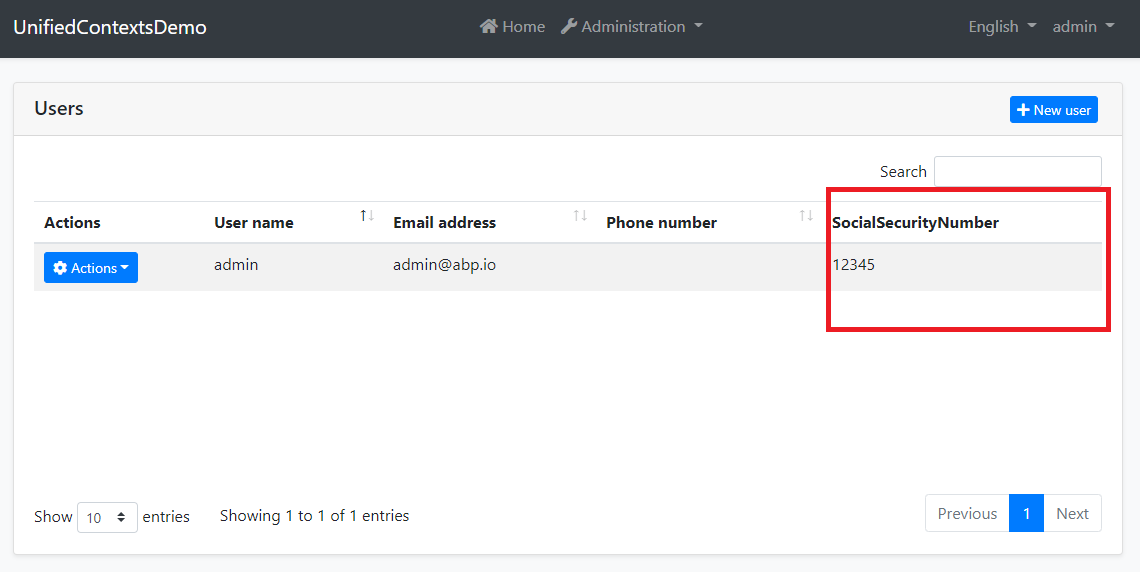原文:Unifying DbContexts for EF Core / Removing the EF Core Migrations Project
在 ABP Framework V4.4 RC 新增功能介绍 中,对应用程序启动解决方案模板做了一个重要改变:删除 EntityFrameworkCore.DbMigrations 项目。
本文将详细解读背后的原因和解决方案。
这篇文件演示如何将解决方案中 EntityFrameworkCore.DbMigrations 项目移除,并实现使用 单个 DbContext 进行数据实体映射和数据迁移。
本篇文章项目源码
关注 ABP Framework 最新开发进度,后面还会陆续发布新功能详解、新功能示例等系列文章,敬请关注!
ABP Framework 研习社(QQ群:726299208)
专注 ABP Framework 学习,经验分享、问题讨论、示例源码、电子书共享,欢迎加入!
如果使用启动模板生成解决方案,数据库提供程序是 Entity Framework Core,那么在解决方案中会存在依赖 EF Core的两个项目:
.EntityFrameworkCore项目:包含应用程序真实的 DbContext、数据库映射和仓储实现。
.EntityFrameworkCore.DbMigrations项目:包含另一个 DbContext 只用于创建和数据迁移。包含所有正在使用的模块的数据实体映射,生成统一的数据库表结构。
分离的原因有两个:
EntityFrameworkCore.DbMigrations 项目中。AppUser 实体映射到数据库中 AbpUsers 表,实际上该表由 Identity 模块 的 IdentityUser 实体映射生成。他们共用相同的数据库表。和 IdentityServer 实体相比 AppUser 包含的属性更少,可以根据需要在 AppUser 中添加所需的属性,只需要设置好数据库映射,新增字段会添加到映射表中。我们详细的描述了这种结构。然而,对于开发者,仍然存在问题,因为当需要复用依赖模块中的表时,这种结构会使的数据实体映射变得复杂。
许多开发者在映射这些类时容易产生误解或犯错,特别是当试图使用的实体与其他实体存在关联关系时。
所以我们在 V4.4 版本中决定取消这种分离,删除 EntityFrameworkCore.DbMigrations 项目。新的启动方案将带只有一个 EntityFrameworkCore 项目和一个 DbContext 类。
如果你想在你的解决方案中加入今天的内容,请遵循本文的步骤。
新的设计有一个缺点。我们必须删除 AppUser 实体,因为不能在同一个 DbContext 中很好地处理没有继承关系的两个类映射到同一张表中。在本文的后面会介绍这个问题,并提供处理它的建议。
如果您使用 ABP Commercial 商业版,ABP套件代码生成功能还不会采用本文中提到的设计方法,建议等待下一个版本。
我们的目标是删除 EntityFrameworkCore.DbMigrations 项目,在 EntityFrameworkCore 项目中启用数据库迁移,替换迁移项目的依赖。
原解决方案是基于 v4.3 创建一个新的解决方案,然后在 pull request 中记录所有的修改,所以你可以逐行看到所有的修改。虽然这篇文章将涵盖所有的内容,但如果你在实现过程中遇到问题,你可能想检查这个PR中所做的修改。
将下面代码添加到 EntityFrameworkCore.csproj 文件:
<ItemGroup>
<PackageReference Include="Microsoft.EntityFrameworkCore.Tools" Version="5.0.*">
<IncludeAssets>runtime; build; native; contentfiles; analyzers</IncludeAssets>
<PrivateAssets>compile; contentFiles; build; buildMultitargeting; buildTransitive; analyzers; native</PrivateAssets>
</PackageReference>
</ItemGroup>
在 EntityFrameworkCore 项目中创建实现 IDesignTimeDbContextFactory<T> 接口的数据上下文工厂
using System.IO;
using Microsoft.EntityFrameworkCore;
using Microsoft.EntityFrameworkCore.Design;
using Microsoft.Extensions.Configuration;
namespace UnifiedContextsDemo.EntityFrameworkCore
{
public class UnifiedContextsDemoDbContextFactory : IDesignTimeDbContextFactory<UnifiedContextsDemoDbContext>
{
public UnifiedContextsDemoDbContext CreateDbContext(string[] args)
{
UnifiedContextsDemoEfCoreEntityExtensionMappings.Configure();
var configuration = BuildConfiguration();
var builder = new DbContextOptionsBuilder<UnifiedContextsDemoDbContext>()
.UseSqlServer(configuration.GetConnectionString("Default"));
return new UnifiedContextsDemoDbContext(builder.Options);
}
private static IConfigurationRoot BuildConfiguration()
{
var builder = new ConfigurationBuilder()
.SetBasePath(Path.Combine(Directory.GetCurrentDirectory(), "../UnifiedContextsDemo.DbMigrator/"))
.AddJsonFile("appsettings.json", optional: false);
return builder.Build();
}
}
}
基本上是从 EntityFrameworkCore.DbMigrations 项目中复制的,重命名并使用应用程序的实际 DbContext 。
复制 EntityFrameworkCore...DbSchemaMigrator(省略号表示项目命名)类到 EntityFrameworkCore 项目中,修改 MigrateAsync 方法中的代码,以使用真实 DbContext 。
using System;
using System.Threading.Tasks;
using Microsoft.EntityFrameworkCore;
using Microsoft.Extensions.DependencyInjection;
using UnifiedContextsDemo.Data;
using Volo.Abp.DependencyInjection;
namespace UnifiedContextsDemo.EntityFrameworkCore
{
public class EntityFrameworkCoreUnifiedContextsDemoDbSchemaMigrator
: IUnifiedContextsDemoDbSchemaMigrator, ITransientDependency
{
private readonly IServiceProvider _serviceProvider;
public EntityFrameworkCoreUnifiedContextsDemoDbSchemaMigrator(
IServiceProvider serviceProvider)
{
_serviceProvider = serviceProvider;
}
public async Task MigrateAsync()
{
/* We intentionally resolving the UnifiedContextsDemoMigrationsDbContext
* from IServiceProvider (instead of directly injecting it)
* to properly get the connection string of the current tenant in the
* current scope.
*/
await _serviceProvider
.GetRequiredService<UnifiedContextsDemoDbContext>()
.Database
.MigrateAsync();
}
}
}
在 迁移 DbContext 中包含 builder.ConfigureXXX() 对应每个使用的模块的数据实体映射配置。移动这些配置到 EntityFrameworkCore 项目的 真实 DbContext 中,并移除 AppUser 数据库实体映射。
可以选择将自己定义的实体数据库映射代码从...DbContextModelCreatingExtensions类中移到 真实 DbContext 的 OnModelCreating 方法中,并删除该静态扩展类。
示例解决方案中,最终 DbContext 代码如下:
using Microsoft.EntityFrameworkCore;
using UnifiedContextsDemo.Users;
using Volo.Abp.AuditLogging.EntityFrameworkCore;
using Volo.Abp.BackgroundJobs.EntityFrameworkCore;
using Volo.Abp.Data;
using Volo.Abp.EntityFrameworkCore;
using Volo.Abp.FeatureManagement.EntityFrameworkCore;
using Volo.Abp.Identity.EntityFrameworkCore;
using Volo.Abp.IdentityServer.EntityFrameworkCore;
using Volo.Abp.PermissionManagement.EntityFrameworkCore;
using Volo.Abp.SettingManagement.EntityFrameworkCore;
using Volo.Abp.TenantManagement.EntityFrameworkCore;
namespace UnifiedContextsDemo.EntityFrameworkCore
{
[ConnectionStringName("Default")]
public class UnifiedContextsDemoDbContext
: AbpDbContext<UnifiedContextsDemoDbContext>
{
public DbSet<AppUser> Users { get; set; }
/* Add DbSet properties for your Aggregate Roots / Entities here.
* Also map them inside UnifiedContextsDemoDbContextModelCreatingExtensions.ConfigureUnifiedContextsDemo
*/
public UnifiedContextsDemoDbContext(
DbContextOptions<UnifiedContextsDemoDbContext> options)
: base(options)
{
}
protected override void OnModelCreating(ModelBuilder builder)
{
base.OnModelCreating(builder);
builder.ConfigurePermissionManagement();
builder.ConfigureSettingManagement();
builder.ConfigureBackgroundJobs();
builder.ConfigureAuditLogging();
builder.ConfigureIdentity();
builder.ConfigureIdentityServer();
builder.ConfigureFeatureManagement();
builder.ConfigureTenantManagement();
/* Configure your own tables/entities inside here */
//builder.Entity<YourEntity>(b =>
//{
// b.ToTable(UnifiedContextsDemoConsts.DbTablePrefix + "YourEntities", UnifiedContextsDemoConsts.DbSchema);
// b.ConfigureByConvention(); //auto configure for the base class props
// //...
//});
}
}
}
从解决方案中移除 EntityFrameworkCore.DbMigrations 项目,将对该项目的引用替换为 EntityFrameworkCore 项目引用。
同样地,将模块依赖 ...EntityFrameworkCoreDbMigrationsModule 替换为 ...EntityFrameworkCoreModule 。
示例项目中,涉及的项目为 DbMigrator Web 和 Web and EntityFrameworkCore.Tests 。
我们需要将 AppUser 这个实体移除,因为 EF Core 不能两个非继承关系的类映射到单个表。所以,删除这个类和所有的对该类的使用。如果你需要在应用程序代码中查询用户,可以用 IdentityUser 替换。更多信息请参见 AppUser 实体和自定义属性部分。
如果需要使用数据迁移历史记录,可以直接将 EntityFrameworkCore.DbMigrations 项目中生成的 migrations 复制到 EntityFrameworkCore 项目,并手动修改其中的 DbContext 类型。
如果需要在已经应用了数据迁移的数据库中,继续应用新的数据迁移,在 EntityFrameworkCore 项目中,创建新的数据库迁移,执行命令:
dotnet ef migrations add InitialUnified
你可以指定一个不同的迁移名称,这将创建一个迁移类,其中包含你在数据库中已有的所有数据库表。注意,删除 Up 和 Down 方法中的所有内容,然后就可以将迁移应用到数据库中。
dotnet ef database update
数据库不会有任何变化,因为迁移是空的,什么都不做。从现在开始,可以在改变实体时,创建新的迁移,就像平时做的那样。
DbContext 合并已经完成。接下来将解决如何基于这种设计为依赖模块的实体添加自定义属性。
数据库映射逻辑、解决方案结构和数据迁移,变得简单和易于管理。
带来的弊端是,我们必须移除 AppUser 实体,因为其与 Identity 模块中 IdentityUser 实体共享 AbpUsers 表。幸运的是,ABP提供了一个灵活的系统来 扩展现有的实体 ,如果你需要定义一些自定义属性的话。
在本节中,我将展示如何向 IdentityUser 实体添加一个自定义属性,并在你的应用程序代码和数据库查询中使用它。
我已经把这部分的所有修改作为一个单独的PR完成了,所以如果你在实现上有问题,你可能想检查这个PR中的修改。
应用程序启动模板提供一个配置点,为实体添加自定义属性,位于 Domain.Shared 项目中 ...ModuleExtensionConfigurator.cs 类,在 ConfigureExtraProperties 方法中,添加代码:
ObjectExtensionManager.Instance.Modules()
.ConfigureIdentity(identity =>
{
identity.ConfigureUser(user =>
{
user.AddOrUpdateProperty<string>( //属性类型: string
"SocialSecurityNumber", //属性名
property =>
{
//validation rules
property.Attributes.Add(new RequiredAttribute());
property.Attributes.Add(new StringLengthAttribute(64));
}
);
});
});
设置完成后,只要运行应用程序就可以看到用户表上的新属性。

新的SocialSecurityNumber属性也将在创建和编辑模式中应用添加的验证规则。
参看 模块实体扩展 文档,理解和使用自定义属性。
ABP默认将所有自定义属性作为一个 Json 对象保存到 ExtraProperties 字段。如果要为自定义属性创建表字段,可以在 EntityFrameworkCore 项目 ...EfCoreEntityExtensionMappings.cs 中配置,在该类(OneTimeRunner.Run)中添加如下代码:
ObjectExtensionManager.Instance
.MapEfCoreProperty<IdentityUser, string>(
"SocialSecurityNumber",
(entityBuilder, propertyBuilder) =>
{
propertyBuilder.HasMaxLength(64).IsRequired().HasDefaultValue("");
}
);
然后,直接在 EntityFrameworkCore 项目中执行添加数据迁移命令:
dotnet ef migrations add Added_SocialSecurityNumber_To_IdentityUser
将在项目汇总添加一个新的数据迁移类,接着可以通过运行 .DbMigrator 应用或如下命令应用修改到数据库:
dotnet ef database update
将会在数据库 AbpUsers 表中添加字段 SocialSecurityNumber 。
现在,可以使用 IdentityUser 实体中 GetProperty 和 SetProperty 方法操作新添加的属性。下面示例代码演示如何获取和设置自定义属性:
public class MyUserService : ITransientDependency
{
private readonly IRepository<IdentityUser, Guid> _userRepository;
public MyUserService(IRepository<IdentityUser, Guid> userRepository)
{
_userRepository = userRepository;
}
public async Task SetSocialSecurityNumberDemoAsync(string userName, string number)
{
var user = await _userRepository.GetAsync(u => u.UserName == userName);
user.SetProperty("SocialSecurityNumber", number);
await _userRepository.UpdateAsync(user);
}
public async Task<string> GetSocialSecurityNumberDemoAsync(string userName)
{
var user = await _userRepository.GetAsync(u => u.UserName == userName);
return user.GetProperty<string>("SocialSecurityNumber");
}
}
提示:使用 SetProperty 和 GetProperty 使用字符串属性名可能会很繁琐,而且容易出错。建议创建以下扩展方法:
public static class MyUserExtensions
{
public const string SocialSecurityNumber = "SocialSecurityNumber";
public static void SetSocialSecurityNumber(this IdentityUser user, string number)
{
user.SetProperty(SocialSecurityNumber, number);
}
public static string GetSocialSecurityNumber(this IdentityUser user)
{
return user.GetProperty<string>(SocialSecurityNumber);
}
}
然后我们可以改变之前的演示方法,如下图所示。
public async Task SetSocialSecurityNumberDemoAsync(string userName, string number)
{
var user = await _userRepository.GetAsync(u => u.UserName == userName);
user.SetSocialSecurityNumber(number); //Using the new extension property
await _userRepository.UpdateAsync(user);
}
public async Task<string> GetSocialSecurityNumberDemoAsync(string userName)
{
var user = await _userRepository.GetAsync(u => u.UserName == userName);
return user.GetSocialSecurityNumber(); //Using the new extension property
}
添加自定义属性之后,我们可能需要基于自定义属性查询。是否可以基于 Entity Framework 的 API 来实现?有两种方式实现在应用程序中使用EF Core API:(这与自定义属性无关,与 EF Core有关。)
EntityFrameworkCore 项目中实现接口。推荐使用第二种方式,在 Domain 项目中定义一个新的仓储接口:
using System;
using System.Threading.Tasks;
using Volo.Abp.Domain.Repositories;
using Volo.Abp.Identity;
namespace UnifiedContextsDemo.Users
{
public interface IMyUserRepository : IRepository<IdentityUser, Guid>
{
Task<IdentityUser> FindBySocialSecurityNumber(string number);
}
}
在 EntityFrameworkCore 项目中实现接口:
using System;
using System.Linq;
using System.Threading.Tasks;
using Microsoft.EntityFrameworkCore;
using UnifiedContextsDemo.EntityFrameworkCore;
using Volo.Abp.Domain.Repositories.EntityFrameworkCore;
using Volo.Abp.EntityFrameworkCore;
using Volo.Abp.Identity;
namespace UnifiedContextsDemo.Users
{
public class MyUserRepository
: EfCoreRepository<UnifiedContextsDemoDbContext, IdentityUser, Guid>,
IMyUserRepository
{
public MyUserRepository(
IDbContextProvider<UnifiedContextsDemoDbContext> dbContextProvider)
: base(dbContextProvider)
{
}
public async Task<IdentityUser> FindBySocialSecurityNumber(string number)
{
var dbContext = await GetDbContextAsync();
return await dbContext.Set<IdentityUser>()
.Where(u => EF.Property<string>(u, "SocialSecurityNumber") == number)
.FirstOrDefaultAsync();
}
}
}
提示:应该使用一个常量代替SocialSecurityNumber魔术字符串。(不会产生拼写错误)
现在,我可以在应用服务中依赖注入 IMyUserRepository 使用仓储接口:
public class MyUserService : ITransientDependency
{
private readonly IMyUserRepository _userRepository;
public MyUserService(IMyUserRepository userRepository)
{
_userRepository = userRepository;
}
//...other methods
public async Task<IdentityUser> FindBySocialSecurityNumberDemoAsync(string number)
{
return await _userRepository.FindBySocialSecurityNumber(number);
}
}
使用自定义仓储接口 IMyUserRepository 代替泛型仓储接口 IRepository<IdentityUser, Guid>。
这篇文章演示了,如何将 EntityFrameworkCore.DbMigrations 项目从解决方案中移除,以简化数据库实体映射、数据迁移和应用程序中的代码。
在下一个版本(4.4),将作为默认处理。
讨论:Consider to remove EntityFrameworkCore.DbMigrations project from the solution #8776
专注.Net开源技术及跨平台开发!致力于构建完善的.Net开放技术文库!为.Net爱好者提供学习交流家园!

ABP Framework:移除 EF Core Migrations 项目,统一数据上下文
原文:https://www.cnblogs.com/YGYH/p/14977399.html